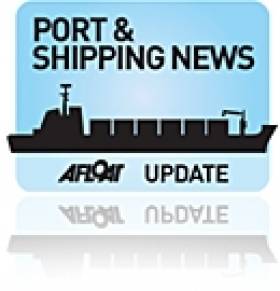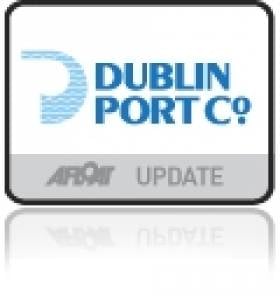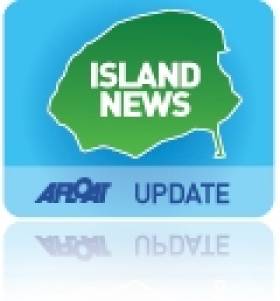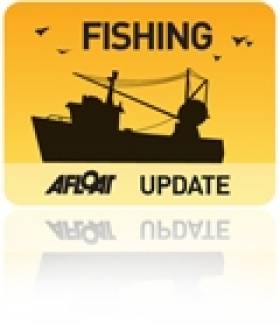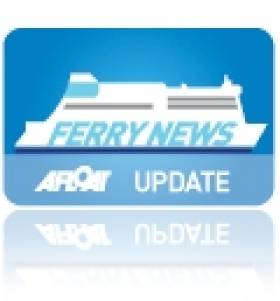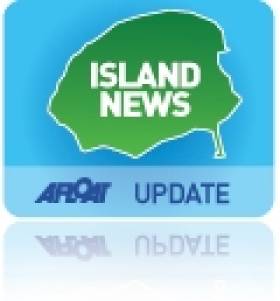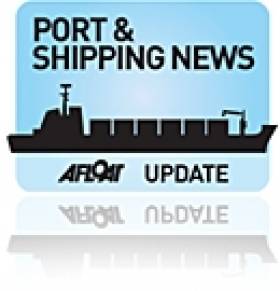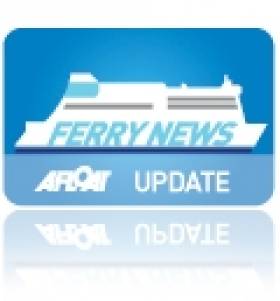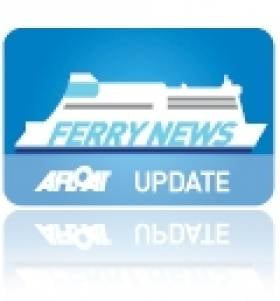Displaying items by tag: ferry
Swansea-Cork Ferry MV Julia For Sale
#SWANSEA CORK FERRY – The merchant ship MV Julia which operated as the Cork Swansea Ferry for the last two years is up for sale following the closure of The Fastnet Line ferry service and the loss of 78 jobs.
According to Dominic Daly Auctioneers the owners of the 1982–built vessel, a Finnish Bank, are inviting offers for the vessel on an 'AS SEEN AS IS' basis'. A guide price is expected shortly
As previously reported on Afloat.ie, the operator had been in examinership since last November, and a restructured business plan had been submitted with a view to resuming high-season service in April. However, in a statement the owners of the Fastnet Line said they had been unable to raise the €1m-plus investment required and that the examinership had "failed".
The ship is currently lying alongside at Cork Port.
The basic details of the vessel are as follows:
IMO Number: 8020642
Year of Build: 1982 (Germany)
Gross Tonnage: 22,161
DWT: 2,880
Net Tonnage: 8,921
LOA: 153.4
Length (BP): 136.02
Breadth: 24.24
Draught: 5.82
Height: 43.0
Displacement: 12,380
Passengers: Unberthed: 1,062
Cabins 344
Berths: 938
Crew: 110
Lorries: 110
Cars: 550
Ro-Ro Lanes: 710m x 5.20m 4.50m
Ramps: 1 Port 5.56 x 6.16 x 0
1 Starboard 5.56 x 6.16 x 0
1 Centre Or Only 9.95 x 6.68 x 0
Bow Door & Ramp, Stern Ramp
Dublin Port Ferry Passenger Numbers fell by 5.6% to 1.7m
#PORTS – Dublin Port Company today published trade statistics for 2011. Total throughput in 2011 was broadly in line with 2010, down by only 0.1% to 28.1m tonnes. Within this, however, exports continued to grow and were up 2.8% in the year at 11.5m tonnes.
2011 trade statistics summary:
Total throughput – 28.1m tonnes, down 0.1%
Exports – 11.5m tonnes up 2.8%
Imports – 16.6m tonnes down 2.0%
Bulk Liquid – 3.6m tonnes, down 4.7%
Bulk Solid – 1.6m tonnes, up 10.8%
Unitised trade now accounts for 81% of Dublin Port's business. During 2011, Ro-Ro freight volumes were virtually unchanged at 725,000 units. In contrast, Lo-Lo volumes fell by 5.1% to 526,000 TEU.
Ferry passenger numbers fell by 5.6% to 1.7m. This follows a record year in 2010 when numbers were boosted by the impact of weather and ash clouds. Compared to 2009, passenger numbers were up 11.1%.
With 1.7m ferry passengers moving through the port, Dublin Port is behind only Dublin Airport and Cork Airport as a national tourism gateway.
The cruise liner side of Dublin Port's business saw a 7.5% increase in cruise passengers. During 2011, 87 cruise ships brought over 135,000 passengers and crew to Dublin.
Commenting on the trade figures, Eamonn O'Reilly, Dublin Port Company's Chief Executive said:
"Trade levels at Dublin Port were steady in 2011 which is a robust performance given the large (6.1%) increase in the port's volumes in the previous year.
"Whereas export volumes have continued to grow and are now 0.5m tonnes higher than they were in 2007, the poor performance of the domestic economy has resulted in a continued decline in imports. These are now 3.4m tonnes lower than they were in 2007.
"Notwithstanding the poor performance of the economy we are continuing to plan for the future and will shortly be launching our Masterplan 2012 to 2040. Dublin remains the largest and most important port on the island and our Masterplan is intended to ensure we continue to provide vital port capacity particularly as the economy returns to growth in coming years.
"With all the difficulties in the economy we are still only 9% behind where we were at the peak in 2007 and we believe that any pick-up in domestic demand will quickly translate into growth in import volumes. The Masterplan will ensure we stay ahead of future growth in demand for decades to come".
Wogan's Visit to Cape Clear Island
#ISLANDS - Cape Clear Island's most well-known couple may get even wider attention now that they're featured in Terry Wogan's new book on Ireland.
Micheál and Sile Ó Ceadagáin – who were the focus of TG4 programme Mí na Meala – are two of the many characters included in Wogan's Ireland, the book accompanying the legendary broadcaster's recent TV series.
According to the blog of the Cape Clear ferry service Cailín Óir: "The photographs [included] are stunning, including those of Cléire and Fastnet, to where Terry enjoyed an idyllic summer’s outing with Micheál on his boat The Gaisceannán.
"Micheál and Sheila are a hospitable couple which extends to the boat and Micheal's famous teas served at sea have pleased many, including the indefatigable Terry."
Wogan's Ireland is packed with photos and stories of Terry's whistle-stop tour of the country's 'coastal fringe', laced with his self-deprecating wit. The book is available online for as little as €10.
#FERRY NEWS - A cross-border project to develop ferry services for island and remote communities of the Irish and Scottish coastlines has received funding in the sixth round of the European Regional Development Fund (EDRF).
A grant of £450,000 (€540,000) has been allocated to procure the world's first ever hybrid RORO ferry for operation in Scotland, following the completion of the INTERREG funded Small Ferries Project.
The project - a cross-border partnership between Caledonian Maritime Assets Limited and administrations in Ireland and Northern Ireland - produced common designs and procurement strategies for a fleet of small ferries which could be used to serve remote coastal communities.
As previously reported on Afloat.ie, five Scottish coastal routes (and three Irish routes) were examined as part of the Small Ferries Project report published in September last year.
Arising from this, Scotland will see the next step in the project by hosting the world’s first hybrid RORO ferry, designed for use on short crossing routes around the Clyde esturary and Hebrides.
The EDRF funding will also be used to develop the corresponding shore infrastructure to enable the ferry to recharge in port.
The first vessel is expected to enter service in Spring 2013.
Licence Application for Aran Islands Fish Farm 'To Be Lodged in January'
#FISHING - The licence application for a proposed new deep-sea fish farm in the Aran Islands is expected to be lodged in January.
As previously reported on Afloat.ie, Bord Iascaigh Mhara's (BIM) planned 15,000-tonne organic salmon farm off Inis Oírr would be the largest of its kind in Europe, and would create hundreds of jobs in the area.
Commenting on the plans, Galway West Senator Fidelma Healy Eames said it was "a major opportunity for Galway and would represent a very significant economic boost for our coastal communities."
She added: "Deep sea fish farming has proven to be very economically beneficial in countries such as Norway, Chile and Scotland. It is timely that Ireland would capitalise on our fantastic marine resources as these countries have."
According to Healy Eames, the project is expected to "meet all environmental standards and will be barely visible from 2km away and effectively not visible from land.
"It would take up a negligible amount of inshore fisheries ground in the bay (0.22%) and would not interfere with existing fishing routes or Galway Bay ferry routes."
Haulier and Driver Found Guilty for Failure to Declare Dangerous Goods
#FERRIES–On 19th February 2008 the Stranraer Police were alerted to an unaccompanied freight trailer which had been off loaded from the Larne to Stranraer Ferry. The officers noticed that the trailer was giving off a strange odour and that it was not placarded. They confirmed with the loading terminal at Larne that the content of the trailer was declared as peat.
When the driver arrived at 8 o clock that evening he told the police that the cargo was aluminium smeltings known locally as "skulls", a by product from smelting and that it gave off dangerous gases and could go on fire if it got wet. He gave the police a copy of the manifest which confirmed that the freight was aluminium smeltings.
The shipper was Tinnelly International Transport, a road haulier who is no longer trading, but was investigated following an incident where an explosion occurred aboard an Irish Sea Ferry on 8th July 2007. During this earlier investigation it was revealed that there is no need to placard the trailer carrying this material under EU legislation while on the road, however under the International Maritime Dangerous Goods Code it must be declared to the shipping company and the trailer must be placarded for transport by sea.
At the Magistrates Court in Larne on Friday 2nd December 2011, Mr McGivern, the driver of the tractor unit that delivered the trailer to the Port of Larne, pleaded guilty to failing to declare a cargo of dangerous goods known as Aluminium Skulls and was fined £3,000 with contribution to costs of £1,000.
Tinnelly International Transport were found guilty of failing to declare the cargo and failing to placard the vehicle, and was fined £10,000 and costs of £6,000.
On summing up the magistrate, Mr Alcorn said:
I am satisfied beyond reasonable doubt that the charges are proved. It is only by the grace of God that something didn't happen. There might have been 500 lives lost.
The driver knew what he was transporting and he risked every life on the ferry.
Mr Alcorn compared the situation to that of the Princess Victoria which still resonates in Larne to this day. None of the guilty parties have set foot in this court in the lead up to this trial, whereas all the witnesses have been brought from Northern Ireland and Scotland because of a "couldn't care less attitude".
Captain Bill Bennett, Area Operations Manager ( Northern Ireland) for the MCA stated that
"This was a serious breach of the International Maritime Dangerous Goods Code with a cargo which is known to give off gases and to explode if it comes in contact with water. P&O Ferries had already banned the product for transportation on their vessels.
New Facilities for Access to Skellig Michael Ferry
Some 10,000 people visit the Unesco world heritage site every year. But a safety audit last year was critical of facilities at Portmagee, finding there was a risk of slipping on concrete steps leading to the boats.
Minister for Transpirt Tourism and Sport Leo Varadkar has earmarked €200,000 to fund the new pontoons for tourist ferries to the island, which will be located in closer proximity to the fishing village.
The Irish Times has more on the story HERE.
Stena Line Opens New Port
The new 27 acre port is one of the most modern port facilities in the UK and heralds the start of a new route between Scotland and Northern Ireland, which will be serviced by two new ships, Stena Superfast VII and Stena Superfast VIII, the largest ferries ever to sail between the two countries.
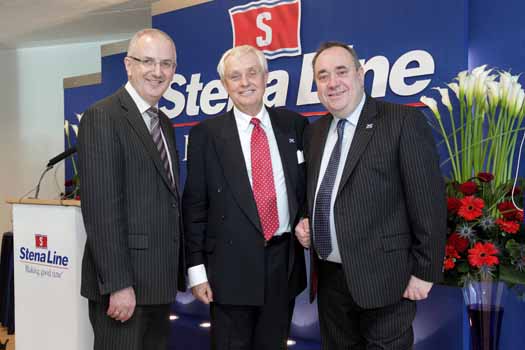
(l-R) Minister for Regional Development Danny Kennedy, MLA, Dan Sten Olsson, Chairman of Stena Line and Scotland's First Minister Alex Salmond
The new ships will complete the crossing in 2 hours 15 minutes and will operate 12 scheduled sailings per day between Cairnryan and Belfast.
The opening of the new port brings Stena Line's recent investment in the service to a massive £200M, which also includes the opening in 2008 of the VT4 port in Belfast, and safeguards the ferry link between Scotland and Northern Ireland for the next generation.
Dan Sten Olsson, Chairman of Stena Line said: "Today is a historic day for the people of Scotland and Northern Ireland. The long term future of this important ferry link between both countries has been secured for future generations and I'm delighted that Stena Line has been able to play its part in maintaining a connection between both countries which goes back over 150 years.
"This investment represents one of the biggest financial route commitments ever made by Stena Line and I'm delighted that after years of planning and hard work the day has finally arrived when we can enjoy using one of the most modern port and terminal facilities in the UK. We have built a facility that will support and stimulate both leisure and freight markets and we are confident that this and the next generation will continue to see ferry travel as an important part of their travel plans."
I am confident that our leisure and freight customers will see that we have taken great care to meet their needs constructing a service and facilities around them and I look forward to the prospect of Cairnryan – Belfast becoming one of the leading ferry services on the Irish Sea."
Speaking at the opening First Minister Alex Salmond said:
"I am absolutely thrilled to be at the Loch Ryan port to open this hugely impressive and important new gateway to Scotland. It is exciting to see how this former brownfield site has been transformed into a 21st century ferry port in less than two years, safeguarding hundreds of jobs at the terminal and ensuring this historic ferry link continues for generations to come.
"As well as being the first of the projects from our Second National Planning Framework to be completed, the work here represents a major investment by Stena Line and is a demonstration of their commitment to Scotland. As passengers will see, the terminal facilities at Loch Ryan are first class, and will serve two outstanding refitted vessels that will reduce journey times and be more fuel efficient. These are exciting times for all those involved in Stena Line, and I extend my warmest congratulations to those that have brought this fantastic project to completion."
Addressing the audience at Loch Ryan today, Minister for Regional Development in Northern Ireland, Danny Kennedy MLA, said: "This significant investment by Stena Line in Loch Ryan complements the company's earlier investment in the modern facilities at the Port of Belfast, which handles 60% of Northern Ireland's seaborne trade.
"The link across the North Channel is of great economic, social and cultural importance to both countries. The recent major investments in harbour facilities in Scotland and Northern Ireland, culminating with the arrival of Stena Line's new ships on this route, will help strengthen this commercial link and its trading position."
Scheduled sailings from the new Loch Ryan Port began on Monday November 21st with 10 crossings per day which will increase to 12 sailings from December 5th.
New Belfast-Cairnryan Route Celebrates First Sailings
#FERRY NEWS - Demotix reports that the first ferries have sailed to Northern Ireland from the new £200m Stena Line port facility at Cairnryan in western Scotland.
The company's final sailings from Stranraer took place at the weekend before the official relocation to the new port, which lies closer to the mouth of Loch Ryan and the North Channel.
As previously reported on Afloat.ie, the Stena Superfast VII is serving the new route following the mothballing of the Stena Voyager service.
The ferry and her sister ship Stena Superfast VIII are on charter from Scandinavian ferry operator Tallink, and are the largest ferries ever to service the North Channel route.
Images of the new Belfast-Cairnryan Stena Line crossing are available HERE.
Stranraer-Belfast Ferry Left Adrift Off Scottish Coast
The Press Association reports that the Stena Navigator was en route from Stranraer to Belfast when both of its engines broke down.
The ferry - carrying 70 passengers and 47 crew - was adrift some four nautical miles west of Corsewall Point lighthouse at the Mull of Galloway.
Clyde Coastguard confirmed that two Svitzer tugs, Norton Cross and Willowgarth, were dispatched to the vessel with the aim of towing it to Belfast, but the ferry managed to get one enging going and propelled itself at half power across the North Channel.
The Navigator arrived in port accompanied by the tugs around 4:30am. No injuries were reported in the incident.


























